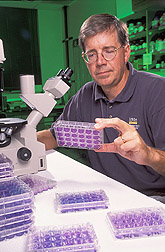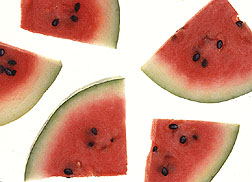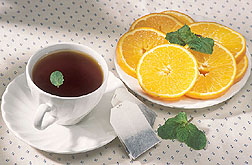This page has been archived and is being provided for reference purposes only. The page is no longer being updated, and therefore, links on the page may be invalid.
| April 2003 |
Check It Out: New Flavonoid DatabaseA comprehensive guide to the amounts of flavonoids in some 224 different foods is now available on the World Wide Web. This authoritative new database is the work of ARS scientists from the Beltsville (Md.) Human Nutrition Research Center, working with colleagues at the ARS Jean Mayer USDA Human Nutrition Research Center on Aging at Tufts University, Boston, Mass., and industry experts. As more data become available, other food items will be added.
Flavonoids, plant compounds that are thought to have healthful properties, include anthocyanidins in blueberries and cherries; catechins in tea, red wine, and apples; and quercetin in onions In addition to antioxidative effects, certain flavonoids may have antimicrobial, anticarcinogenic, and cardioprotective properties, as well. Researchers who are evaluating associations between flavonoid intake and reduced risk of certain diseases should find the new database especially useful. For more information, contact Joanne M. Holden, (301) 504-0630; USDA-ARS Beltsville Human Nutrition Research Center, Beltsville, MD What Food Compounds Forestall Type 2 Diabetes?Ongoing laboratory studies by ARS scientists may add to the list of compounds in foods that help reduce the risk of a disorder known as insulin resistance. About 16 million Americans are insulin-resistant, meaning that they can't properly use insulin to get energy-rich glucose from their blood into cells that need it. Insulin resistance often leads to type 2 diabetes, the most common form of diabetes in the United States. Scientists at the ARS Western Regional Research Center, Albany, Calif., have developed insulin-resistant laboratory hamsters and are now using the animals in novel studies. Insulin resistance occurred in the lab animals within only a few weeks after the researchers put the hamsters on a high-fat regimen, similar in proportion to the amount of fat that most Americans eat every day. The experiments should identify food compounds that protect the animals from becoming insulin-resistant. Use of laboratory animals that are insulin-resistant isn't new. But the California researchers are likely the first to develop this condition in hamsters by increasing the amount of fat that the animals consumed. For more information, contact Qiming Shao, (510) 559-5669; USDA-ARS Western Regional Research Center, Albany, CA On-The-Go Nutrition Van Reaches More VolunteersA 40-foot-long mobile research lab is now bringing nutrition studies to people and communities that previously might not have been included in these investigations. 
The customized van enables scientists based at the ARS Grand Forks (N.D.) Human Nutrition Research Center to reach youngsters, the elderly, and other individuals who generally aren’t able to easily travel to research facilities. The scientists designed and equipped their on-the-go lab with everything that they require to evaluate volunteers' eating habits, nutritional status, general physical and mental health, and other factors key to the investigations. For instance, the researchers have already taken their mobile lab to three of North Dakota’s four Native American reservations to collect needed data. The scientists will use study results to develop recommendations to improve nutrition in these communities. For more information, contact James G. Penland, (701) 795-8471; USDA-ARS Grand Forks Human Nutrition Research Center, Grand Forks, ND Simplifying Production of a Low-Calorie SweetenerMannitol--the pleasant-tasting, powdery coating on chewing gum, hard candy, and pills--might soon be made with the help of a hard-working microbe. Most of today's mannitol is manufactured using a relatively inefficient process. However, scientists at the ARS National Center for Agricultural Utilization Research in Peoria, Ill., now have shown that a strain of beneficial Lactobacillus intermedius can produce mannitol from sugar such as high-fructose corn syrup. It can do that more efficiently than current commercial processes. USDA has patented the microbe and the technology for using it and now is working with a company to commercialize the research. Mannitol has fewer calories than sugar and is used as a low-calorie sweetener. For more information, contact Badal C. Saha, (309) 681-6276; USDA-ARS National Center for Agricultural Utilization Research, Peoria, IL Vegan, Omnivore Bone Health ProbedPeople who eat animal-derived foods such as meat, poultry, or dairy products are likely to lose more calcium from their bones than people who eat less of these items, one theory in nutrition research suggests. But scientists at the ARS Western Human Nutrition Research Center at Davis, Calif., and their university colleagues have findings that run counter to that idea.
The scientists analyzed the eating patterns and key bone-health indicators of 48 healthy, nonsmoking women, aged 18 to 40, who volunteered for a 10-month study. Twenty-two of the volunteers were vegans, who don't eat animal products, and 26 of the women were omnivores, who do. Contrary to what previous research had suggested, the rate at which calcium was removed from bones of the volunteers--for other uses by their bodies--was the same for omnivore women as for the vegan women. A second unexpected finding: the vegan volunteers formed new bone at a significantly faster rate than the omnivore volunteers. That happened even though the vegans were eating less calcium than the omnivores. Both the vegans and the omnivores took in about the same amount of other bone-building nutrients, such as magnesium. The study is part of ongoing research at the Davis nutrition center to identify nutrition-based ways to reduce the risk of osteoporosis. This disease causes dense, healthy bones to become weak, thin, porous, and more likely to fracture. An estimated 10 million Americans have osteoporosis. Another 28 million are at risk. For more information, contact Marta D. Van Loan, (530) 752-4160; USDA-ARS Western Human Nutrition Research Center, Davis, CA Vitamin K Link to Bone Health ExaminedVitamin K may be essential to one aspect of bone health for women, but not necessarily for men. Scientists funded by ARS looked at vitamin K intake from food and at bone mineral density measures from the hip and spine of male and female participants in the 1996-2000 Framingham Heart Study. Low mineral density at the hip and spine--indicative of porous bone--may increase risk of fractures. The investigators found that the Framingham women who had the lowest vitamin K intake also had, on average, significantly lower bone mineral density. That was in comparison to the female volunteers who had the highest intakes of this nutrient. The vitamin K intake of men participating in the study did not seem to be related to their bone mineral density at the same two skeletal points (February 2003 American Journal of Clinical Nutrition, vol. 77, pp. 512-516). Scientists at the ARS Jean Mayer USDA Human Nutrition Research Center on Aging at Tufts University, Boston, Mass., did the analysis on data from 2,591 Framingham volunteers aged 29 to 86. Further studies may help explain why low vitamin K intake and low bone mineral density correlated in women but not in men. This disparity is especially puzzling because of earlier work which linked low vitamin K intake to increased risk of hip and spine fractures in both sexes. Good sources of vitamin K include green leafy vegetables and vegetable-based oils and spreads. For more information, contact Sarah L. Booth, (617) 556-3231; ARS Jean Mayer USDA Human Nutrition Research Center on Aging at Tufts University, Boston, MA Radio Waves Blast Bacteria in Fruit JuiceRadio waves show new promise as a powerful way to zap bacteria in fruit juice. Using RFEF, or radio frequency electric fields, as a pasteurization technique isn't a new idea. However, ARS scientists at the Eastern Regional Research Center, Wyndmoor, Pa., may be the first to successfully inactivate a bacterium in fruit juice using radio waves and moderate heat. For their experiments, the scientists introduced--into apple juice--a harmless form of Escherichia coli known as E. coli K12. This microbe mimics the behavior of its pathogenic foodborne cousin, E. coli O157:H7. They reduced the E. coli K12 by 99.9 percent by exposing the juice to radio frequencies and moderate heat of about 122 degrees F. The researchers expect that, with further development, the treatment will meet the required 99.999 percent kill rate that today's heat pasteurization provides. Processors of fruit juices, vegetable juices, and liquid egg products could benefit from a pasteurization treatment that doesn't change product flavor or nutritional value. For more information, contact David J. Geveke, (215) 233-6507; USDA-ARS Eastern Regional Research Center, Wyndmoor, PA Vitamin A Interactions With Immune System InvestigatedVitamin A can help our immune systems fight certain kinds of infections, like those caused by some food-borne pathogens. But scientists have not yet determined why this essential nutrient may be less helpful in combating other pathogens, such as those that cause some types of pneumonia. 
ARS research aimed at helping solve that puzzle may, in turn, yield better ways to capitalize on the ability of vitamin A-rich foods to boost the immune system. At the ARS Western Human Nutrition Research Center, Davis, Calif., scientists are delineating vitamin A's influence on the types and amounts of beneficial cells and compounds that the immune system produces in response to attack. In an early experiment, the researchers supplied animal immune cells with a form of vitamin A called 9-cis retinoic acid, and exposed the cells to a simulated attack. This work showed--for the first time--that more of the immune cells quickly evolved into what are known as T-2 helper cells than into T-1 helper cells. The difference is important because T-2 helper cells apparently are more proficient in fighting some pathogens than others. In humans, that difference could strongly affect how quickly the body is able to overcome a particular pathogen. The researchers used mouse immune cells for these petri dish tests, but they now plan to repeat the tests with laboratory mice--not just their cells. Studies with healthy adult volunteers may follow. Foods that provide vitamin A include beef, chicken, turkey, sweet potatoes, spinach, and tomato products. For more information, contact Charles B. Stephensen, (530) 754-9266; USDA-ARS Western Human Nutrition Research Center, Davis, CA Researchers Fine-Tune Estimates of Women's Calorie NeedsCurrent recommendations for the number of calories that healthy women need for everyday life are based, in part, on research from the ARS Children's Nutrition Research Center at Baylor College of Medicine, Houston, Texas. In the March 2003 American Journal of Clinical Nutrition (vol. 77, pp. 630-638), scientists describe an investigation to fine-tune women's calorie requirements. The variability in total energy expended by the 116 female volunteers underscored the need to include at least four different levels of physical activity, ranging from sedentary to very active. Previous national recommendations were set for only a light-to-moderate activity level. The researchers used a novel, stable-isotope method to measure volunteers' total energy expenditure over a 2-week period. The research is a key starting point for more precisely determining the calorie needs of women during pregnancy and throughout breast-feeding. That should help ensure healthy weights for new moms and their infants. For more information, contact Nancy F. Butte, (713) 798-7179; USDA-ARS Children's Nutrition Research Center at Baylor College of Medicine, Houston, TX Medicinal Uses for Watermelon Rind ExploredWatermelon rind, an old-time favorite for pickling, contains an important natural compound called citrulline. ARS scientists who were comparing the citrulline content of the sweet, juicy flesh of commercially grown watermelon determined that the rind is also a good source of this biochemical. 
Citrulline is an amino acid that the body makes from food. One of citrulline's key roles is to create another amino acid, arginine. Some people are deficient in arginine. A watermelon-rind-based extract or dietary supplement might address this deficiency. Scientists at the ARS Natural Products Utilization Research Unit, Oxford, Miss., and the ARS South Central Agricultural Research Laboratory, Lane, Okla., conducted the citrulline analyses. For more information, contact Agnes M. Rimando, (662) 915-1037; USDA-ARS Natural Products Utilization Research Unit, Oxford, MS, or Penelope Perkins-Veazie, (580) 889-7395; USDA-ARS South Central Agricultural Research Laboratory, Lane, OK Soy's Iron May Be More Available, After AllSoybeans’ iron, in the form of ferritin, may be more available for our bodies to use than was previously thought. If that preliminary research result holds true in further studies, it could increase soy’s value as an iron source, to the benefit of the 30 percent of the world's population that, is deficient in this essential nutrient. 
ARS scientists have investigated the topic since 1994. More recently, agency researchers grew high-ferritin, Tokyo variety soybeans with a naturally occurring, trackable form of ferritin inside. They provided the soybeans for a new, 28-day nutrition study led by investigators at Pennsylvania State University and the Children’s Hospital Oakland (Calif.) Research Institute. The 18 female volunteers, aged 19 to 23, who participated in the test were each slightly deficient in iron. The women ate muffins made with flour from the Tokyo soybeans, had their iron levels tested 14 days later, then repeated the procedure with soy broth. The rate of iron absorption averaged about 27 percent. That's in contrast to the 5 to 10 percent that the scientists had expected, based on previous results from human volunteers (January 2003 American Journal of Clinical Nutrition, vol. 77, pp. 180-184). Their analyses will reveal how much of the absorbed iron was in the form of ferritin. For more information, contact Ross M. Welch, (607) 255-5434; USDA-ARS U.S. Plant, Soil and Nutrition Laboratory, Ithaca, NY Men’s Capacity To Form Vitamin A VariesA California-based study provides new and important evidence that healthy men vary in their natural ability to convert beta-carotene into vitamin A. Scientists at the ARS Western Human Nutrition Research Center and the University of California at Davis conducted the investigation with 11 male volunteers, aged 25 to 40. 
The study was a follow-up to an earlier ARS test that had shown surprising differences in the capacity of female volunteers to use beta-carotene as a precursor of vitamin A, an essential nutrient. At prescribed intervals throughout the 7-week study, the men were fed trackable forms of beta-carotene at breakfast. In the American Journal of Clinical Nutrition (May 2002, vol. 75, pp. 900-907) the researchers report that the men's absorption of beta-carotene ranged from 0 to 8 percent of the dose. In turn, conversion of the beta-carotene to vitamin A ranged from undetectable to 75 percent of the absorbed dose. Conversion of beta-carotene to vitamin A is likely a gene-linked trait. New discoveries about the interaction of beta-carotene and our genes could lead to customized recommended daily intakes. For more information, contact Betty J. Burri, (530) 752-4748; USDA-ARS Western Human Nutrition Research Center, Davis, CA |
|
The United States Department of Agriculture (USDA) prohibits discrimination in all its programs and activities on the basis of race, color, national origin, gender, religion, age, disability, political beliefs, sexual orientation, and marital or family status. (Not all prohibited bases apply to all programs.) Persons with disabilities who require alternative means for communication of program information (Braille, large print, audiotape, etc.) should contact USDA's TARGET Center at 202-720-2600 (voice and TDD). To file a complaint of discrimination, write USDA, Director, Office of Civil Rights, Room 326-W, Whitten Building, 14th and Independence Ave., SW, Washington, DC 20250-9410 or call 202-720-5964 (voice or TDD). USDA is an equal opportunity provider and employer. |



